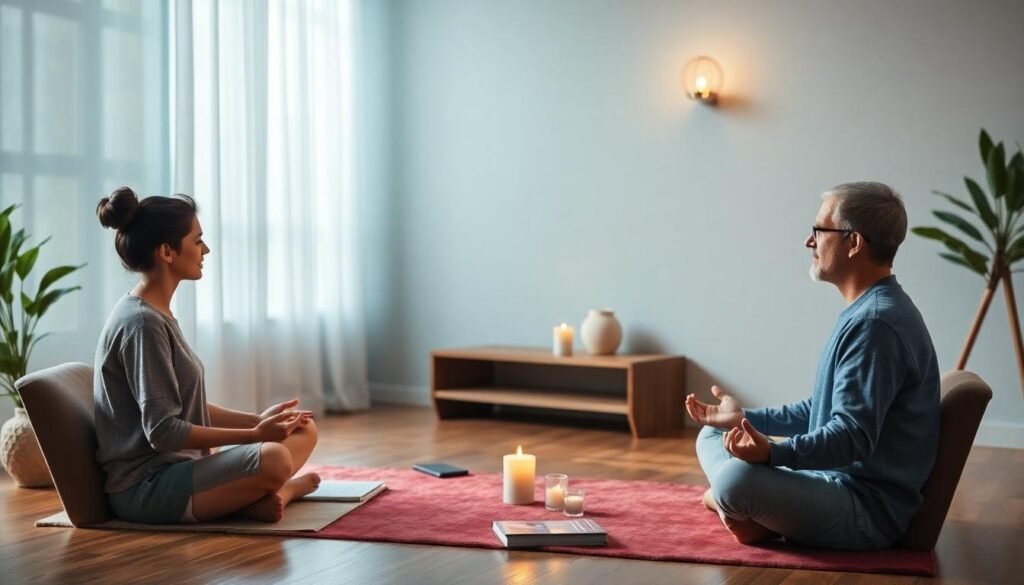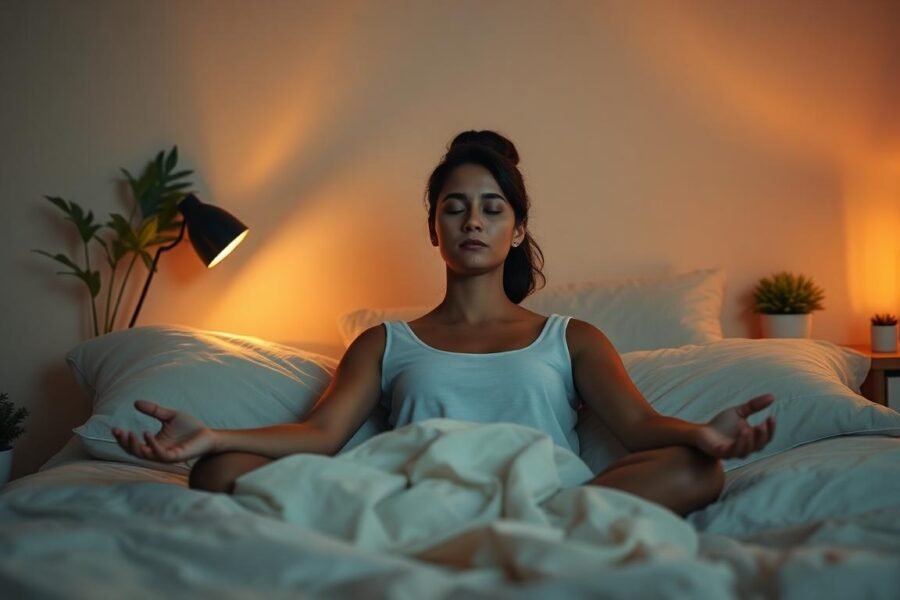Anxiety has become increasingly common in people’s lives. Seeking ways to relieve it and care for your mental well-being is essential for maintaining balance and quality of life. Guided meditation for anxiety relief and calming the mind offers an accessible path for those who want more serenity in their daily routine.
This practice guides your focus and breathing, making relaxation easier even for beginners. With benefits such as increased concentration, better sleep, and reduced stress, guided meditation stands out for promoting mental health and well-being in a simple and effective way.
Understanding Anxiety and Its Effects on the Mind
Anxiety is part of everyday life for millions and directly affects our emotions, thoughts, and behaviors. Understanding how it impacts not only our mood but also our physical health is crucial when looking for practical solutions—like guided meditation for anxiety relief. Below, we explore symptoms, everyday impacts, and the importance of emotional balance techniques.
Common Symptoms of Anxiety
Anxiety symptoms vary, but many people experience physical and emotional signs that disrupt their routine. The most reported include:
- Heart palpitations and increased heart rate
- Excessive sweating
- Shaking and muscle tension
- Headaches and chest pain
- Difficulty breathing or feeling short of breath
- Dry mouth and nausea
- Dizziness or faintness
- Insomnia or trouble sleeping
- Constant worry, irritability, and trouble concentrating
- Avoidance behaviors and social withdrawal
These symptoms often appear during stress or intense worry, but when persistent, they can severely impact quality of life and require care.
The Impact of Anxiety on Daily Life and the Nervous System
When anxiety becomes constant, it alters how the mind and body function. The nervous system activates an alert state in response to perceived threats—important for survival, but harmful when prolonged.
In daily life, chronic anxiety can:
- Reduce focus and memory retention
- Affect performance at work or school
- Increase the risk of conflict in relationships
- Disrupt sleep and physical vitality
- Cause unexplained pain or physical discomfort
Constant stimulation of the autonomic nervous system—responsible for automatic functions like heartbeat and breathing—can lead to persistent fear, hypervigilance, and exhaustion.
The Need for Practical Emotional Balance Techniques
Given the intensity of symptoms, it’s essential to seek practical and accessible ways to restore emotional balance. Investing in mental health means more than treating symptoms—it means learning to manage emotions and build resilience.
Effective strategies include:
- Self-awareness: Identify emotional triggers, thought patterns, and reactions.
- Healthy routines and boundaries: Set regular schedules, take time to relax, and know when to say “no.”
- Physical activity: Exercise is a proven ally in reducing anxiety.
- Positive relationships: Emotional support improves well-being.
- Breathing and relaxation techniques: Deep breathing, mindfulness, and guided meditation help regulate emotional responses.
- Professional support: Therapy and counseling enhance long-term results.
Guided meditation for anxiety relief fits perfectly into this framework. With regular practice, you can train your mind to exit alert states, ease physical symptoms, and cultivate a lasting sense of peace. This approach strengthens mental health and promotes a lighter, more centered life.
Techniques and Benefits of Guided Meditation for Anxiety Relief

Guided meditation for anxiety relief is based on evidence-backed techniques that help regulate the body and calm racing thoughts. Grounded in scientific research, it works as mental training to promote relaxation, focus, and emotional balance. Through verbal instructions, the practice guides you into states of mindfulness, controlled breathing, and physical relaxation—making it easier to reduce stress and anxiety.
Below are the main techniques and physiological and psychological effects that explain why this method is so effective for mental well-being.
Core Techniques of Guided Meditation
Mindfulness (Present-Moment Awareness)
This involves observing the present moment consciously and without judgment. During the session, the guide prompts the listener to focus on the breath, body sensations, or ambient sounds. This reduces mental looping and anxious thinking. Mindfulness is the foundation of programs like MBSR (Mindfulness-Based Stress Reduction).
Conscious Breathing
This technique focuses on slow, intentional breathing. Guided sessions help you observe your breath’s rhythm and use it to reduce tension. It activates the parasympathetic nervous system, helping to regulate physical symptoms like rapid heartbeat and muscle tightness.
Guided Visualization
This method invites you to imagine calming environments—such as a beach, forest, or mountain—through verbal direction. Visualizing peaceful settings generates positive emotions and interrupts anxious thought patterns, offering a sense of safety and emotional relief.
Progressive Muscle Relaxation
Here, you’re guided to tense and then release different muscle groups, from the feet up to the face. This technique builds awareness of physical tension and helps you release it, promoting a sensation of lightness and calm.
These techniques can be combined to boost results. Audio, video, and meditation apps are especially helpful for beginners looking for guidance and consistency.
Physiological and Psychological Effects of Regular Practice
Consistent guided meditation for anxiety relief not only shifts thoughts—it also transforms the body’s internal systems. Scientific studies show real biological and psychological changes, including:
- Lower Cortisol Levels: Regular meditation reduces cortisol, the stress hormone. Less cortisol means less pressure on both the body and mind.
- Positive Brain Changes: Neuroimaging reveals growth in the prefrontal cortex—linked to emotional regulation and attention. Brain waves associated with relaxation (alpha and theta) also increase.
- Slower Heart and Breathing Rates: Meditation activates the parasympathetic nervous system, decreasing heart rate, blood pressure, and breathing rate for deep relaxation.
- Emotional Balance: Practitioners often report reduced anxiety, improved emotional control, better sleep, and sharper mental clarity.
- Other Health Benefits: Meditation can strengthen the immune system, relieve chronic pain, and help manage conditions like hypertension. Results become more pronounced with frequent and consistent practice.
In short, guided meditation is a comprehensive tool for wellness. It soothes both body and mind, reshapes stress-related brain patterns, and creates a space where anxious thoughts lose their power. This opens the door to a deeper sense of calm—even amid daily life’s unpredictability.
Step-by-Step Guide for Practicing in Moments of Crisis or Tension

In times of crisis or heightened tension, many people struggle to regain emotional control. Guided meditation for anxiety relief offers a simple yet powerful method to break the spiral. With a structured routine, you can turn moments of distress into opportunities for calm and self-awareness. Below is a clear guide for preparing your space, positioning your body, maintaining focus, and conducting a short guided practice during episodes of anxiety.
Preparation: Setting, Posture, and Focus
Choose the Right Space: Pick a quiet place with low foot traffic and soft lighting. Avoid areas associated with stress or that have many distractions.
Turn Off Electronics: Silence phones and app notifications. If possible, use headphones to follow the guided audio and block external noise.
Get Comfortable: Sit on a chair or cushion with your spine straight yet relaxed. Keep your feet flat or legs crossed, depending on your preference.
Position Your Hands: Rest your hands on your thighs or lap, tension-free. You may keep them open facing up (receptive posture) or loosely closed.
Practice Conscious Breathing: Before starting, take three deep breaths—in through the nose, out through the mouth. This signals your brain it’s time to relax.
Anchor Your Attention: Gently bring your awareness to the present. If thoughts arise, acknowledge them without judgment and return to the meditation flow.
These simple steps help build a welcoming internal and external environment, reducing stressors and easing you into calm at the very start of the practice.
Practical Guided Meditation for Anxiety Episodes
During a wave of anxiety, following a simple script can ease your transition back to emotional stability. This can be done through audio, video, or even a written guide if you prefer to lead yourself.
Follow these steps:
- Acknowledge the Moment: Admit to yourself that anxiety is present. Name what you’re feeling and notice any physical symptoms.
- Settle In: Sit comfortably with your spine aligned and your body grounded. Feel the contact between your body and the floor or seat.
- Gently Close Your Eyes: This reduces visual input and directs attention inward.
- Focus on Your Breathing: Inhale through your nose while counting to four, letting your belly expand. Hold for two seconds. Then exhale slowly through your mouth while counting to six. Repeat this cycle for a few minutes.
- Body Scan: Shift your awareness gradually from your feet to your head, noticing and relaxing any tension you find along the way.
- Choose an Anchor: Focus on a calming word, a sound (like your breath), or a mental image (such as a peaceful beach). Return to this anchor when distractions arise.
- Accept Thoughts and Emotions: If fear or worry shows up, acknowledge it without judgment. Observe your feelings as if they were clouds passing through the sky. Then gently return to your chosen anchor.
- Close the Practice: Take three final deep breaths. Open your eyes slowly, move your hands and feet gently, and pause for a few moments before returning to your routine.
Ideal Duration: In acute situations, 5 to 12 minutes is enough to ease symptoms. For regular maintenance, aim for 10–20 minutes, 3 to 5 times a week.
Helpful Tips for Staying Consistent:
- Meditate at similar times daily to train your brain for consistency
- Use trusted guided meditation audios or apps
- Journal 2–3 short notes after each session to track how you felt
Guided meditation in crisis moments acts like a conscious pause. It allows you to notice, feel, and accept emotions—bringing a sense of grounding and presence. Practice with patience and kindness, remembering each session is progress toward better mental health.
Incorporating Guided Meditation into Your Routine and Seeking Support
To fully benefit from Guided Meditation for Anxiety Relief, consistency is key. Turning it into a daily habit allows the effects to compound and become part of your overall well-being. In addition, using practical tools and social support can keep you motivated and help you progress—especially when facing obstacles or doubts.
How to Integrate Meditation into Your Daily Routine
Including guided meditation in your day doesn’t require drastic changes. What matters most is creating a small, dedicated space for it—even just a few minutes. Here are some practical tips to get started:
- Set a Fixed Time: Choose a consistent time each day—whether early morning, during a work break, or before bed. This regularity helps form the habit.
- Start with Short Sessions: Begin with 5 to 10 minutes per session. Over time, increase the length based on your comfort and availability.
- Create a Cozy Space: Find a quiet place with soft lighting and minimal noise. A chair, cushion, or mat is all you need.
- Stick to Simple Postures: Keep your spine upright and relaxed. Comfort is more important than formality.
- Combine with Other Relaxing Activities: Meditation can accompany walks, stretches, or calming music.
Once the habit is in place, the benefits grow. You’ll notice better mental clarity, reduced reactivity to stress, and greater emotional balance throughout the day.
Using Apps, Videos, and Supportive Resources
Technology can be a great ally when practicing Guided Meditation for Anxiety Relief. Digital tools make the practice more accessible, even for beginners.
- Meditation Apps: Platforms like Headspace, Calm, and Insight Timer offer guided meditations, calming soundtracks, and anxiety-specific programs. Just choose a session, put on your headphones, and follow along.
- Videos and Podcasts: YouTube and Spotify host thousands of guided meditation videos and audio sessions. Explore different styles to find what suits you.
- Reminders and Alarms: Set daily notifications on your phone to keep meditation part of your schedule—especially on busy days.
- Practice Journals: After each session, jot down a few thoughts about how you felt. This builds self-awareness and tracks your progress.
These tools make meditation more engaging and consistent, helping you stick with the habit long-term.
Joining Groups and Seeking Social Support
Sharing your journey makes meditation more sustainable. Being part of a community enhances motivation, offers clarity, and fosters a sense of connection.
Here’s how to build supportive relationships around your practice:
- Join Local or Online Groups: Many meditation centers, churches, or community spaces host weekly sessions. Online, you’ll find plenty of groups on social media.
- Enroll in Courses or Workshops: Structured programs help deepen your knowledge and commitment.
- Use In-App Communities: Some apps include forums and chat spaces for users to share tips and experiences.
- Practice with Friends or Family: Meditating with a partner can boost motivation and accountability.
Support from others helps lighten the journey and reinforces your commitment to mental wellness.
When to Seek Professional Help
While Guided Meditation for Anxiety Relief offers many benefits, professional support may be necessary in certain situations. Pay attention to warning signs like:
- Persistent anxiety interfering with your daily life, relationships, or work
- Intense physical symptoms such as chronic insomnia, unexplained pain, or frequent panic attacks
- Inability to carry out everyday tasks or take care of yourself
- Deep sadness, hopelessness, or thoughts of self-harm
In such cases, meditation is a helpful supplement but not a substitute for therapy or medical care. A qualified professional can guide your healing journey safely and effectively.
Practicing regularly, supported by tools and community, strengthens the impact of Guided Meditation for Anxiety Relief—making calm and well-being possible even in today’s fast-paced world.nte, tornando possível alcançar serenidade e bem-estar mesmo diante dos desafios do cotidiano.
Conclusion
Guided Meditation for Anxiety Relief has proven its value both through scientific research and the lived experiences of those who practice it. It reduces stress, improves sleep, enhances mental clarity, and strengthens emotional health. With regular practice, you begin to notice real shifts—more calm in the face of challenges and greater self-control during stressful moments.
Making meditation a part of your self-care routine is an act of respect for your mental well-being. You don’t need perfection—just the willingness to try and return to the practice each day, even if only for a few minutes.
Try incorporating Guided Meditation for Anxiety Relief into your daily life. Over time, the benefits build and reshape your relationship with anxiety and stress. Your well-being begins with a small, gentle step toward self-care.
Thank you for reading this guide. Feel free to share your thoughts and encourage others to take care of their minds and emotions through this simple yet powerful practice.






Deixe um comentário